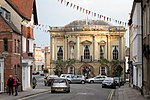Kennet District
English districts abolished in 2009Former non-metropolitan districts of WiltshireWiltshire geography stubs
Kennet was a non-metropolitan local government district in Wiltshire, England, abolished as part of the 2009 structural changes to local government. It was named after the River Kennet. The district was formed on 1 April 1974, under the Local Government Act 1972, by a merger of the municipal boroughs of Devizes and Marlborough, alongside Devizes Rural District, Marlborough and Ramsbury Rural District and Pewsey Rural District. The district council was based at offices in Devizes. It was abolished on 1 April 2009 as part of the structural changes to local government in England, when its functions were taken over by the new Wiltshire Council unitary authority.
Excerpt from the Wikipedia article Kennet District (License: CC BY-SA 3.0, Authors).Kennet District
St. John's Street,
Geographical coordinates (GPS) Address Nearby Places Show on map
Geographical coordinates (GPS)
| Latitude | Longitude |
|---|---|
| N 51.352 ° | E -1.995 ° |
Address
Fox in the House
St. John's Street 4
SN10 1HR
England, United Kingdom
Open on Google Maps











